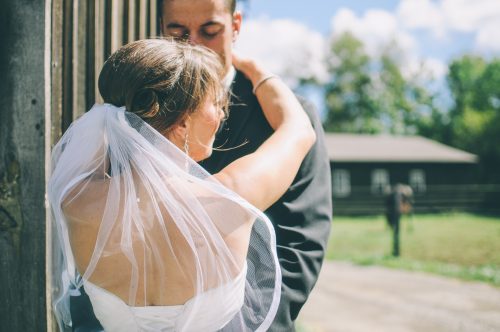 Marriage hasn’t always been about mutual love between two people. In fact, it often hasn’t. In the beginning, marriage was nothing at all to do with love or religion.
Marriage hasn’t always been about mutual love between two people. In fact, it often hasn’t. In the beginning, marriage was nothing at all to do with love or religion.
5th century
According to Stephanie Coontz, author of Marriage, a History: How Love Conquered Marriage*, it began as a strategical tool sometime in the early Anglo-Saxon period around 500 AD. Coontz says “You established peaceful relationships, trading relationships, mutual obligations with others by marrying them”. So marriage began as a way of surviving, helping out or pacifying your neighbour instead of fighting with them. Who married who was decided by tribal leaders, matching up their children according to the importance of each family, or the childbearing potential of a daughter. There would be no choice in the matter for the future couple – it was an entirely loveless beginning.
We know very little about what a marriage ceremony would have been like, but it would certainly have been nothing like a modern one. The indigenous religion in England around this time was still a form of paganism, so there would be no churches, no ministers, and certainly no honeymoon!
6th century
Somewhere between 550 and 570 AD, Æthelberht, the king of Kent, married Bertha, daughter of the king of the Franks, the most powerful state at the time in Western Europe. Forming a peaceful alliance with their neighbour was the main reason for this marriage, with religion completely irrelevant – at the time he was a Pagan, whilst she was a Christian.
597
Pope Gregory I sends a mission from Rome, led by Augustine, to convert the Anglo-Saxons to Christianity. This mission met with Æthelberht, the most powerful ruler in Britain, and managed to convert him to Christianity in the same year, no doubt helped by the fact that his wife was already Christian. With the king of the Anglo-Saxons now a Christian, and the accessibility of a religion where you only needed to worship a single god instead of messing about with several different ones, Christianity began to take hold.
Middle 7th century to the 9th century
Christianity gradually becomes the dominant religion in Britain.
11th century
During the 11th century the use of money had become widespread, and a family’s wealth would no longer be indicated by how many cattle or sheep they had, but by the number of coins they possessed. The pairing up of couples therefore began to be dictated by money instead of goods. The purpose of marriage was still all about survival, and there was now nothing better than money to ensure that your family lived on.
12th century
Around 1140, with Christianity now the dominant religion, we finally see mutual love starting to become an important aspect of marriage (it only took 600 years!), thanks to the Italian canon lawyer Gratian. He wrote the canon law textbook Decretum Gratiani, which required that couples give their consent to form a marital bond. Before this time there was no single source of canon law in the Roman Catholic Church, and no set way of getting married. Gratian combined many different and often contradictory sources of canon law into his textbook, an effort so spectacular that it retained legal force until 27 May 1917.
14th century
Marriage licences were granted from the 14th century onwards, and allowed marriage to take place with only seven days notice by paying a fee. They would be issued either by a Bishop, Dean, the Archbishop’s Office or another ecclesiastical official, and were used by the gentry, yeomen and merchant classes as a means to show they were wealthy and could afford one. So for some individuals at least, marriage is still being used to show one’s wealth and importance rather than one’s love for another.
Other reasons for marrying this way included speed (Shakespeare and Anne Hathaway applied for an Archbishop’s Licence just seven months prior to their first baby being christened), confidentiality, and anyone intending to marry on a Fast day or during Lent.
1530s
In the 1530s the Archbishop of Canterbury, Thomas Cranmer, helped Henry VIII annul his marriage to Catherine, so he could marry Anne. This was the beginning of the English Reformation, and caused the Church of England to break away from the Roman Catholic Church.
1543
Henry VIII signs the Treaty of Greenwich with the Scots, betrothing his son Edward VI to the seven month old Mary, Queen of Scots, to secure peace between England and Scotland. So even though love had started to become an important part of marriage 400 years earlier with Gratian, it was still of little consequence in some situations, especially those involving money and power.
1549
Former Archbishop of Canterbury Thomas Cranmer scripts the wedding vows for the Church of England in his Book of Common Prayer. The Act of Uniformity 1549 then made this the sole legal form of worship in England. It contained the first wedding vows written entirely in English and is largely the same as what we know today. This represents an important stage in the gradual changing of the purpose of marriage, away from securing wealth and power, and towards mutual love.
Clergy are also permitted to marry.
1552
The Act of Uniformity 1552 updates the Book of Common Prayer with a more Protestant version, and is again written by Thomas Cranmer. Anyone attending or administering a service not using this liturgy faces a six month imprisonment for a first offence, one year for a second offence, and life for a third. Fines were also imposed for non-attendance at church.
1553 to 1558
Upon the death of Edward VI, Mary I restores Roman Catholicism as the sole allowed form of worship in England. She actively persecutes Protestants during this time, passing legislation which judges them guilty of heresy against the Roman Catholic faith. According to contemporary accounts, around 300 Protestants are burned to death during her reign.
1558
The Elizabethan Age, from 1558 to 1603, began with a brief return to calmer times after the religious persecutions brought about by Henry VIII and the split from Rome. Upon Mary’s death in late 1558, her Protestant half-sister Queen Elizabeth wanted Protestants and Catholics to be able to take Holy Communion according to their own beliefs. Through the Act of Uniformity 1558, some revisions were made to the Book of Common Prayer, which allowed both Protestant and Catholic services to take place.
1598
Queen Elizabeth ordered the previously loose-leafed baptism, marriage and burial registers to be copied into parchment books in order to improve record keeping.
1611
The new translation of the Bible is published for the Church of England.
1753
The Marriage Act 1753 (more commonly known as known as Lord Hardwicke’s Marriage Act) marked the beginning of state involvement in marriage. Prior to this, everything was decided by canon law. The Act stated that each parish had to keep a record of all marriages registered there, thus making record finding considerably easier after this period.
1812
The third major act was passed regarding baptism, marriage and burial registers; George Rose’s Act of 1812. It specified that transcripts should be made by each church on parchment within two months of the end of each year and forwarded to the registrar. The registers were also ordered to be kept in a ‘dry well painted iron chest, in some dry and secure place, either at the parsonage or in the church’. As a result, many iron chests were built in 1813, and you can still find thousands of them remaining to this day.
1836
The Marriage Act of 1836 allowed for non-religious marriages to be held in register offices by civil registrars. Before this time you had to get married in the Church of England, regardless of your religion. Marriage otherwise would be almost pointless, as it would carry no weight in the eyes of the law. This Act also further improved the record keeping of marriages, as from this time all marriages in England and Wales have been recorded on one central register. Records typically contain the names of each couple, the date of marriage, and the parish where the marriage was registered.
1850s
In the middle of the nineteenth century, legislation began to reduce the power and responsibilities of the Church. The Ecclesiastical Courts Act 1855, the Matrimonial Causes Act 1857, and the Ecclesiastical Courts Jurisdiction Act 1860 gradually moved marriage regulation into the hands of the State.
1854
Central registration began in Scotland on 1st January 1855 following the Registration of Births Deaths and Marriages (Scotland) Act 1854.
1886
The Marriage Act 1886 allowed marriages to take place between 8 am and 3 pm, instead of the previous restriction between 8 am and 12 pm. It applied to England and Wales only.
1949
The Marriage Act 1949 is the basis of current marriage legislation, although it has been amended several times since it came into force. This act came into effect on January the 1st 1950 and abolished marriage entirely for those under 16 years of age in England and Wales.
1969
In 1969 the Divorce Reform Act was passed. Before this time it was too expensive for most people to divorce, and the aggrieved partner also had the enormous challenge of proving adultery – usually the only way to end the relationship. From now on couples could split much easier, simply by reason of marital breakdown. As soon as one person wanted it to be over, then it was, in theory at least.
2005
In 2005 civil partnerships were introduced under the Civil Partnership Act 2004, to give same-sex couples the same legal rights as married couples.
2012
The Protection Of Freedoms Act 2012 was given Royal Assent on 1 May 2012. This removed the restriction from the Marriage Act 1949 that marriages must take place between 8 o’clock in the morning and 6 o’clock in the evening.
2013
The Marriage (Same Sex Couples) Act 2013 was given Royal Assent on 17 July 2013. From Saturday the 29th March 2014, same sex marriages were allowed in England and Wales. By the end of 2014 it is expected civil partners will be able to convert their civil partnership into a marriage.
The Act preserves the Canon law of the Church of England, which states that marriage is between opposite-sex couples only. The Church of England, Catholic Church and Church in Wales all still oppose same-sex marriage, and no religion is obliged to perform them under the Act.
